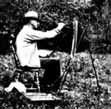The WPA
and Artists
During the Great Depression,
many artists who were working in printing, illustration, graphic arts, advertising,
and other professional fields became unemployed because businesses could no
longer afford to keep them.
In 1934, Franklin Roosevelt
created the Works Progress Administration's Fine Arts Program (FAP) for the
purpose of employing artists, writers, musicians, and actors, who, for a weekly
wage and art supplies, made artworks for public buildings, and archives of
interviews, narratives, and photographs for the nation. Often the artworks
were on specific WPA-guided themes, such as American Scene or Americans at
Work. Goals of the program were to celebrate American art and to integrate
more art into small town America.
Artists received about
$25 per week. They were required to produce one finished work of art per month
and put in a certain number of hours. Some artists taught classes in WPA schools.
The program gave artists supplies and access to studios such as printing shops.
This afforded artists time to work at home to develop their skills and their
styles. Many artists who were in the WPA credit the program with enhancing
their lives.
 Gertrude
Abercrombie, a Chicago painter, was able to move into an apartment
of her own and become a full-time, professional painter who exhibited
and sold her work regularly. She credits the WPA program, in which
she worked from 1934 to 1940 and earned $94 per month, with validating
her quest for independence and her status as an artist.
Gertrude
Abercrombie, a Chicago painter, was able to move into an apartment
of her own and become a full-time, professional painter who exhibited
and sold her work regularly. She credits the WPA program, in which
she worked from 1934 to 1940 and earned $94 per month, with validating
her quest for independence and her status as an artist.
 Emil
Armin, also of Chicago, found work with the WPA from 1933 to 1940.
He produced oils and watercolors for the easel program, and even became
an assistant supervisor of the Illinois Art Project. It allowed him
to paint full-time and spend summers painting in the Indiana Dunes
with fellow artists.
Emil
Armin, also of Chicago, found work with the WPA from 1933 to 1940.
He produced oils and watercolors for the easel program, and even became
an assistant supervisor of the Illinois Art Project. It allowed him
to paint full-time and spend summers painting in the Indiana Dunes
with fellow artists.
 Julia
Thecla worked in the easel painting section of the FAP in Chicago. The
program gave her the economic security to continue developing as an artist.
Previously she was forced to take many supplemental jobs such as jewelry
restoration and china painting to survive.
Julia
Thecla worked in the easel painting section of the FAP in Chicago. The
program gave her the economic security to continue developing as an artist.
Previously she was forced to take many supplemental jobs such as jewelry
restoration and china painting to survive.
There are many such
stories about artists who benefited from the WPA's Art Projects. The nation
also benefited with a treasure trove of paintings, prints, murals, sculptures,
and other works that today reside in public and private collections and in
buildings nationwide.
Related Activities:
People at Work (html) (pdf)
Link to
Depression Era Art Module Activities
https://www.museum.state.il.us/muslink/art/htmls/de_actres.html

